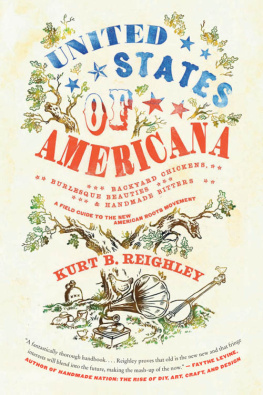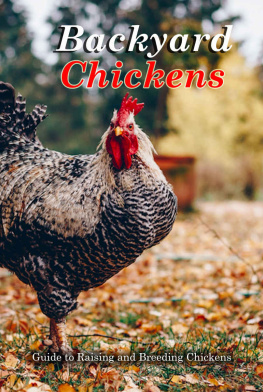For Mark
Contents

I n 1997, satirical newspaper the Onion ran a story under the headline U.S. Dept. of Retro Warns: We May Be Running Out of Past. According to fictitious experts, as pop culture trends came back into vogue with shorter intervals between, the past was in danger of achieving parity with the present. A decade later, those predictionsridiculous or notseem to have come true. In 2008, as the nation slogged through another terrible recession and record unemployment, how much comfort could citizens find in revisiting trends and fashions from the 1970s and 80s?
No wonder some began reaching back even further, to simpler times theyd never known firsthand. In a quest to find something of substance in an accelerated world, these modern pioneers are latching on to handcrafts, well-made shoes, gospel and bluegrass musicthings that have waxed and waned in popularity, but have endured through eras of prosperity and hardship alike. Theyve opted to invest in one hand-tailored garment, or a hunting jacket made to the same specifications for over a centurya piece of clothing they might hand down to their childrenrather than buy a new American Apparel hoodie every six months. Theyve stopped paying exorbitant gourmet prices for sun-dried or roasted tomatoes, and started learning to can their own, fresh from a local, sustainable source, maybe their own yard or a nearby farmers market. Theyve started noting the arrival of each weeks ripe and ready new crops the way clothes hounds anticipate Fashion Week. Musicians are declining to spend their time hunched over yet another computer, and are forming old-time string bands instead, and then posting the results on their MySpace page. (Ironically, all this looking back has been accelerated by the Internet.)
A generation or two ago, our parents interacted with their neighbors and community members in a much more intimate way. They relied on local craftsmen to repair shoes, tailor trousers, or suggest the best cut of meat for dinner. To Generation X, that mentality can seem downright weird. Who repairs shoes? When sneakers wear out, you just throw them away... right? But as big-box stores and cheap goods have driven the valuable, highly skilled services of cobblers, tailors, and butchers to the brink of extinction, the romance of a blacksmith or old-fashioned barbershop is exerting tremendous, practical appeal to Generation D.I.Y.
Today, in almost any city, you can find a watering hole or boutique that looks suspiciously like it was cobbled together from sets of old Westerns or Sherlock Holmes serials. Burnished wood and taxidermy busts adorn the walls. Jukeboxes pump out Hank Williams and Bill Monroe sides. Patrons who only recently came of drinking age order small-batch, local whiskey and pre-Prohibition cocktails. (To quote a popular bourbon ad, Lewis & Clark Didnt Load the Canoe with Mojitos.) And that server with the smart mouth? On weekends shes a trapeze artist, or a burlesque queen. Probably both.
Whether the subject is beat-up work boots, sequin-encrusted brassieres, or cigar box banjos, more and more folks share similar sentiments. In music, the umbrella term Americana encompasses a variety of contemporary artists who use time-tested sounds, such as delta blues or classic country, as a jumping-off point to something new. That impulse isnt limited to songwriters and bands. Its sphere expands every day, throughout fashion, grooming, food, and entertainment. Plenty of people would rather bolster their sense of identity, and become better acquainted with neighbors and friends, by exploring essential favorites from every corner of Americas past. They are going back to their roots, in pursuit of goods that will endure and the know-how to maintain them, to the sustenance of tastes and sounds that delighted their grandparents and great-grandparents.
The Real Thing
As a growing number of discerning young Americans opt out of gambling on fads and fashion, the currency of authenticityand the connotations of history and experience that word carriesrises in value. Companies like Red Wing and Pendleton Woolen Mills have survived two world wars and the Great Depression, which speaks volumes about the quality and reliability of their products. Theres also some magical thinking afoot here: we want to believe not only that Carhartt knows what its doing after 120 years of manufacturing work clothes, but also that by wearing their product we connect with some of that accrued wisdom and experience.
People want to have real, genuine, authentic things, says Christina Vernon of Wolverine, whove made boots since 1883. Thanks to the protracted recession and mounting concerns about conservation, she predicts that demand will only increase. The throwaway society is going to go awayor be greatly diminished.
On the other hand, there are plenty of savvy, younger entrepreneurs who attach the idea of authenticity to their wares too. They point to attention to classic details and time-honored methods as proof of their commitment to doing things right. These relative newcomers sense the public is dizzy from a million sales pitches honed in marketing meetings and focus groups; instead they emphasize transparency in their operations, with tags like classic American workmanship.
Since World War II, the production of essential goodsfood, clothing, machineryhas moved off Main Street, to an industrial park somewhere on the outskirts of town, then possibly to China or El Salvador. As that detachment grows greater, and the processes by which the things we buy are manufactured and reach our shelves become more opaque, many people are responding with heightened curiosity.
These pioneers understand that buying a product, being a consumer, is only the final step in a long journey. They want to choose their own adventure from the beginning. If they appreciate the sauerkraut and pickled green tomatoes of San Franciscos Bubbies, they may sign up to learn pickling and preserving at a Canning Across America workshop. They want to get closer to the processes so they not only know exactly what theyre getting, but also have a deeper sense of where their money goes and the practices it subsidizes once its spent.
Small American craft businesses have had to pull back the curtain and expose the inner workings of their operations, and thats good. They cant reduce costs the way vendors who use cheaper overseas labor can, so they emphasize offering valuenot bargains. They cant compete with China or India or the Dominican Republic today, observes Kevin Shorey of Quoddy, Inc., a Maine footwear maker. So they have to say, Heres what were makingand it is better than what theyre making. And that has really raised the bar for American-made products.
Americas heritage is teeming with invention and ingenuity that are still alive today. If you were one of those kids subjected to one too many field trips to Colonial Williamsburg or Plymouth Rock, you might be surprised at how fascinating the labors of butchers and soap makers can be (especially once you lose the tricornered hats and breeches).
In order to appreciate some of Americas greatest traditions, occasionally we have to set aside preconceived notions and stereotypes. Just because the passing pickup drivers who harassed you as an adolescent nonconformist were blaring Lynyrd Skynyrd shouldnt discourage curious music lovers from investigating the Drive-By Truckers; as a legion of alt-country fans have learned, American roots music can resonate as powerfully as punk rock. A woman who knits can still be CEO of a Fortune 500 company. Heck, one of the biggest resources for information on home canning is not a division of some corporate agribusiness giant, but part of the U.S. Department of Agriculture (USDA).
Next page








